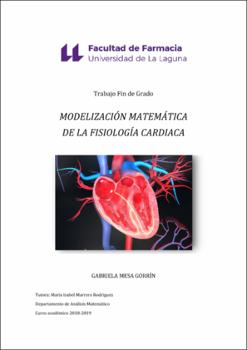Modelización matemática de la fisiología cardíaca
Author
Mesa Gorrín, GabrielaDate
2019Abstract
This study aims to explain, through a mathematical model, the physiology of the heart. To
this end, the model proposed by Zeeman in 1972 has been chosen. It highlights three
characteristics of the heartbeat cycle: it exhibits a state of equilibrium corresponding to
diastole; it incorporates a triggering threshold of the electrochemical wave that emanates
from the pacemaker and causes the heart to contract in systole; and, finally, it reflects the
rapid return to the state of equilibrium.
First, a local linearized model is obtained that explains the diastolic state through an
autonomous system of differential equations. Next, in order to include the state of systolic
equilibrium, some modifications are made to this system. To conclude the final form of the
model, the phase plane diagram associated with the resulting system is analyzed.
Zeeman’s model is not the only one possible but, in addition to reflecting reasonably well
the basic features of the heartbeat cycle, it has been quite successful in distinguishing some
extreme forms of heartbeat behavior, such as the effects of high blood pressure or an excess
of adrenalin in the bloodstream.
The study concludes with a tentative modeling of the cardiac pacemaker firing mechanism. Este estudio tiene como objetivo explicar, mediante un modelo matemático, la fisiología del
corazón. Se ha elegido el modelo propuesto por Zeeman en 1972, el cual destaca tres
características del ciclo cardiaco: exhibir un estado de equilibrio correspondiente a la
diástole; incorporar un umbral desencadenante de la onda electroquímica que emana del
marcapasos y que hace que el corazón se contraiga en sístole; y, por último, reflejar el rápido
retorno al estado de equilibrio.
En primer lugar, se obtiene un modelo linealizado local que explica el estado diastólico a
través de un sistema autónomo de ecuaciones diferenciales. Seguidamente, a fin de
contemplar el estado de equilibrio sistólico, se introducen algunas modificaciones en este
sistema. Para concluir la forma definitiva del modelo se analiza el diagrama del plano de
fase asociado al sistema resultante.
El modelo de Zeeman no es el único posible pero, además de reflejar razonablemente bien
las características básicas del ciclo cardiaco, es capaz de distinguir algunas formas extremas
del comportamiento del latido, como los efectos de la hipertensión o de un exceso de
adrenalina en el torrente sanguíneo.
El estudio concluye con una modelización tentativa del mecanismo disparador del
marcapasos cardiaco.





